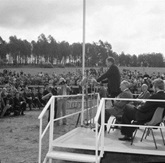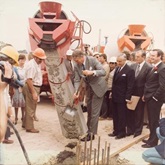|
1979
|
Parliament House Construction Authority
|
|
| |
The Parliament House Construction Authority is established by the Parliament House Construction Authority Act 1979 in March 1979 as the advisory authority on behalf of the Parliament. Its role is 'to undertake and carry out the design and construction of Parliament House'.
|
|
|
1979
|
International design competition
|
|
| |
In April 1979 the National Capital Development Commission announces an architectural competition for the design of the New Parliament House.
After consultation with the Royal Australian Institute of Architects and the National Capital Development Commission, the Parliament House Construction Authority issues a brief and competition documents including formal guidelines called Conditions for a Two Stage Competition. Key aspects of the brief include:
Parliament House must be more than a functional building. It should become a major national symbol, in the way that the spires of Westminster or Washington's Capitol dome have become known to people all over the world. Strength and originality of image will determine the extent to which the building becomes associated in people's minds with national politics....It is important that the building reflect the significance of the national Parliament and Executive Government in the Australian political and social context. The extent to which the building asserts this significance is related to questions of scale and monumentality. Careful consideration should be given to the implications of the scale and monumentality of the design...
The building and site treatment should respond to those qualities of environment which are uniquely Australian - climate, landscape, vegetation and quality of light....The philosophy which the building expresses, and its popular success, will depend in part on the extent to which public access and involvement is encouraged by the design. Parliament House should not appear remote and inaccessible. Access to both the site and the building should be facilitated. Within the building, connotations of a 'people's Parliament' and 'open government' will be established if people can penetrate the building and observe its operation. [1]
|
|
|
1979
|
Design competition finalists
|
|
| |
On 5 April 1979 Parliament clears the first-stage competition documents and architects registered in Australia are invited to register for the competition. [2]
By the time registrations close on 31 May, 961 applications have been received for the first stage of the design competition. A total of 329 entries are submitted from 28 countries by the 31 August closing date for the Stage One competition. Of these, 10 finalists are identified with five invited to go through to Stage Two of the competition while five prize-winners are recognised but do not proceed in the competition.
|
|
|
1979
|
Second Stage Competition
|
|
| |
The Second Stage Competition for designing Parliament House commences in November 1979.
The five first-stage finalists are Bickerdike Allen Partner (London); Denton Corker Marshall Pty Limited (Melbourne); Edwards Madigan Torzillo Briggs International (North Sydney); Mitchell/Giurgola & Thorp (New York); and Christopher Waite (British Columbia). The finalists are given a sum of money to assist in preparing the second-stage submission which requires detailed plans and models. The entrants are expected to demonstrate that they have the expertise and ability necessary to complete the design process. [3]
|
|
|
1980
|
Winning design
|
|
| |
On 26 June 1980 New York-based architectural company Mitchell/Giurgola & Thorp is announced as the winner of Stage Two of the Parliament House design competition.
The assessors' report on the winning scheme notes its unpretentiousness and accessibility where children 'will not only be able to climb on the building but draw it easily too'. [4] According to the architect, Romaldo Giurgola:
The magic relationship between geometry and land configurations of that plan, after that, often became the object of my architectural dreams. The brief for the design of the parliament compiled by the NCDC was possibly the best I had ever encountered in my professional career. I plunged into Australian literature rather than into guides and travelogues. Patrick White, Miles Franklin, Henry Lawson and Les Murray became my real instructors, while the sonorous voice and accent of Richard Thorp, the Australian in our office, produced the right atmosphere. [5]
The winning architectural team is responsible for the design conception, siting and architecture, as well as the interior design, furniture design, landscape, and coordination of the art and craft program for Parliament House. [6] Romaldo Giurgola, moves to Canberra to implement his design, bringing a team of eight people from the New York office. Four of the team, including Romaldo Giurgola, stay in Australia after the project's completion. [7]
|
|
|
1980
|
Turning the first sod
|
|
| |
The Prime Minister the Rt Hon. Malcolm Fraser (LP, Member for Wannon, Vic., 1955‒83) turns the first sod on the site of the New Parliament House on 18 September 1980. [8]
|

Prime Minister the Rt Hon. Malcolm Fraser addresses guests at the ceremony to turn the first sod for construction of the new and permanent Parliament House, Capital Hill, Canberra
Image courtesy of National Archives of Australia
|
|
1980
|
Construction phase approved
|
|
| |
On 28 August 1980 the House of Representatives approves the proposal from the Parliament House Construction Authority for the construction on Capital Hill of a new and permanent Parliament House. [9]
|
|
|
1981
|
Schematic design presented to House
|
|
| |
On 18 August 1981 the Hon. Michael Hodgman QC (LP, Member for Denison, Tas., 1975‒87), Minister for the Capital Territory, presents the sixth report of the Joint Standing Committee on the New and Permanent Parliament House relating to the revised design brief and to the schematic design. He states:
It is my hope that this report and a separate report by the Joint Standing Committee on the New Parliament House will result in Parliament's agreeing to proceed with the construction of this exciting and much needed building. The design has been acclaimed as a building for the 21st century and beyond and will be the focal point for world attention when it is completed. It will be a measure of Australia's standing not only in architecture but also as a developed nation. [10]
|

Untitled (Prime Minister Malcolm Fraser with shovel and the pouring of cement at Parliament House construction site), Parliament House Art Collection, Canberra ACT, No. 06/0082.015
Image courtesy of Parliament House Art Collection, Canberra ACT
|